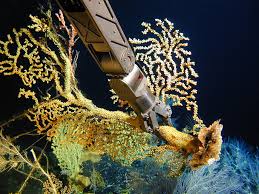2014年1月2日Nature杂志封面文章:深海夏威夷金珊瑚
加州大学圣克鲁兹分校海洋科学系的研究人员利用来自K. haumeaae珊瑚的氮同位素((15N)记录证明,固氮的增加在150年前左右就已经开始了,而且它可能与“小冰期”末以来北半球的气候变化有关。相关文章发表于2013年12月15日的《Nature》杂志上。

2014年1月2日Nature杂志封面文章:深海夏威夷金珊瑚
本期封面所示为NOAA/HURL Pisces V潜水器一次下潜过程中获得的深海夏威夷金珊瑚Kulamanamana haumeaae在其生活环境中的图像。这种珊瑚是一种非常长寿的物种,有时能活数千年。
在数千年间,这些珊瑚提供一个独特的地球化学时间序列,因为它们会将下沉的浮游植物和其他微小颗粒转化成一种蛋白质性质的珊瑚骨架。北太平洋副热带环流的初级生产力在最近几十年有所提高,尽管营养供应下降了。生态系统所发生的一个朝向固氮浮游生物群落的变化曾作为一个可能的解释被提出,但造成这种变化的原因仍不清楚。
Owen Sherwood及同事利用来自K. haumeaae珊瑚的氮同位素((15N)记录证明,固氮的增加在150年前左右就已经开始了,而且它可能与“小冰期”末以来北半球的气候变化有关。
原文摘要:
Increasing subtropical North Pacific Ocean nitrogen fixation since the Little Ice Age
Owen A. Sherwood, Thomas P. Guilderson, FABIan C. Batista, John T. Schiff & Matthew D. McCarthy
The North Pacific subtropical gyre (NPSG) plays a major part in the export of carbon and other nutrients to the deep ocean. Primary production in the NPSG has increased in recent decades despite a reduction in nutrient supply to surface waters. It is thought that this apparent paradox can be explained by a shift in plankton community structure from mostly eukaryotes to mostly nitrogen-fixing prokaryotes. It remains uncertain, however, whether the plankton community domain shift can be linked to cyclical climate variability or a long-term global warming trend. Here we analyse records of bulk and amino-acid-specific 15N/14N isotopic ratios (δ15N) preserved in the skeletons of long-lived deep-sea proteinaceous corals collected from the Hawaiian archipelago; these isotopic records serve as a proxy for the source of nitrogen-supported export production through time. We find that the recent increase in nitrogen fixation is the continuation of a much larger, centennial-scale trend. After a millennium of relatively minor fluctuation, δ15N decreases between 1850 and the present. The total shift in δ15N of −2 per mil over this period is comparable to the total change in global mean sedimentary δ15N across the Pleistocene–Holocene transition, but it is happening an order of magnitude faster. We use a steady-state model and find that the isotopic mass balance between nitrate and nitrogen fixation implies a 17 to 27 per cent increase in nitrogen fixation over this time period. A comparison with independent records suggests that the increase in nitrogen fixation might be linked to Northern Hemisphere climate change since the end of the Little Ice Age.

